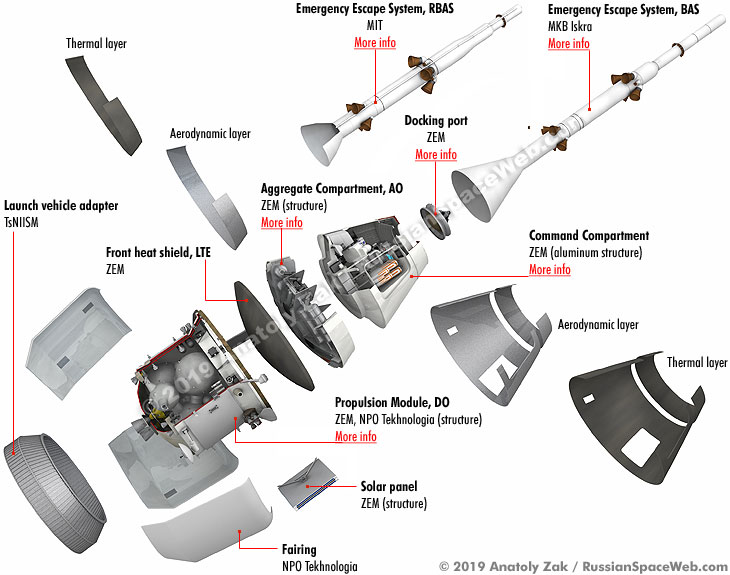kvs wrote:
So the thrust will be higher. That is why there was talk about getting to Mars in under 2 months.
now finally Rogozin can troll Musk



kvs wrote:
So the thrust will be higher. That is why there was talk about getting to Mars in under 2 months.



Hole wrote:And use the Soyuz-5 to shoot a Aurus into space.



Roscosmos chief says Soyuz MS version for flights to Moon to cost $400 mln
The Soyuz was initially designed as a spacecraft for the Moon’s exploration and, therefore, it has the potential to boost its thermal and radiation protection, the Roscosmos chief said
MOSCOW, March 25. /TASS/. The creation of the Soyuz MS spacecraft’s version with the enhanced thermal and radiation shield for flights to the Moon will cost about $400 million, Head of Russia’s State Space Corporation Roscosmos Dmitry Rogozin said on Monday.
The Soyuz was initially designed as a spacecraft for the Moon’s exploration and, therefore, it has the potential to boost its thermal and radiation protection, the Roscosmos chief said.
"We are now considering using this spacecraft for flights around the Moon, including as a commercial project. The project’s initial cost may equal about $400 million: this involves creating the spacecraft and organizing one mission," Rogozin said.
A modernized Soyuz spacecraft can be launched to the Moon using a two-launch scheme: an upgraded Soyuz spaceship is launched aboard a Soyuz carrier rocket and is temporarily docked with the International Space Station (ISS) and then a booster is launched with the help of an Angara heavy rocket. After that, the booster and the spaceship are assembled on the orbital outpost, after which they make a flight around the Moon, perform a gravitational maneuver and return to Earth," Rogozin said.
From the viewpoint of thermal and radiation protection, a modernized Soyuz spacecraft will feature "actually a second hull," the Roscosmos chief said.
The Roscosmos chief earlier said that NASA had requested Russia to develop the Soyuz spacecraft’s version for flights to the Moon to have a backup space transportation system. The United States plans to implement the Deep Space Gateway program with the participation of other countries to create a permanent lunar orbital station to regularly receive spacecraft from Earth.
More:
http://tass.com/science/1050328
George1 wrote:Russian space agency to cut cost of Proton-M rocket’s launch to Falcon 9’s level
More:
http://tass.com/science/1050342
George1 wrote:
"We are now considering using this spacecraft for flights around the Moon, including as a commercial project. The project’s initial cost may equal about $400 million: this involves creating the spacecraft and organizing one mission," Rogozin said.
i thought "Federation" was for moon orbit.



George1 wrote:...i thought "Federation" was for moon orbit.
PapaDragon wrote:George1 wrote:...i thought "Federation" was for moon orbit.
It was NASA that requested this platform to be developed as a backup for flights to cis-lunar station
Looks like nobody is in the hurry to put the old horse out to pasture
Should be simple enough so why not make it as long as they don't screw up Federation development (serious possibility)

 Soyuz-5
Soyuz-5

 Soyuz-5
Soyuz-5
USA has no man rated rocket ATM because they chose not to have it when they retired shuttle not because they can't have one
yep … a tunnel pretty much dictated the Roscosmos "strategy" …

 options
optionsRussian space firm launches production of new Soyuz-5 carrier rocket
The Soyuz-5 rocket is designed for launches from the Baikonur Cosmodrome as part of the Baiterek joint project with Kazakhstan
SAMARA, May 31. /TASS/. The Progress Space Rocket Center based in Samara in the Volga area has launched the production of a new Soyuz-5 carrier rocket, Progress CEO Dmitry Baranov said on Friday.
"Now we have launched the production of [fuel] tanks of the Soyuz-5 carrier rocket. We have no right to disrupt the deadline of the rocket’s production and believe we are able to comply with it," the chief executive said.
The Soyuz-5 (Irtysh) medium-class carrier rocket is being developed by Energia Space Rocket Corporation. The rocket is designed for launches from the Baikonur Cosmodrome as part of the Baiterek joint project with Kazakhstan.
The Soyuz-5 will be able to deliver the promising manned Federatsiya spacecraft into a low near-Earth orbit. The Soyuz-5 is set to be developed by 2021. During the new rocket’s flight tests, its four launches are planned to be carried out in 2022-2025.
More:
http://tass.com/science/1061151
Russia developing Soyuz-5 rocket to capture commercial launch market
The Soyuz-5 medium-class carrier rocket is being developed by Energia Space Rocket Corporation
MOSCOW, May 31. /TASS/. Russia is creating its new Soyuz-5 carrier rocket to capture the market of commercial launches. The new rocket will be competitive price-wise with its US rivals, Chief of Russia’s State Space Corporation Roscosmos Dmitry Rogozin said on Friday.
"We have some reserve potential as well and we are ready to compete with them. The Soyuz-5 rocket is aimed at capturing the commercial market, and not only for solving state objectives. It should be competitive price-wise so that even with all our rivals’ economic policy tricks, they won’t be able to cut it to a level that could pose a challenge to us," Rogozin said.
As was reported on Thursday, the US Department of Defense included Russia in the list of countries whose services cannot be used after December 31, 2022 in carrying out space launches. A notification to this effect was uploaded by the Pentagon’s Federal Acquisition Regulation System to the website of the Federal Register - the daily journal of the US Government.
The Soyuz-5 (Irtysh) medium-class carrier rocket is being developed by Energia Space Rocket Corporation. The rocket is designed for launches from the Baikonur Cosmodrome as part of the Baiterek joint project with Kazakhstan. The Soyuz-5 will be able to deliver the promising manned Federatsiya spacecraft into a low near-Earth orbit.
The Soyuz-5 is set to be developed by 2021. During the new rocket’s flight tests, its four launches are planned to be carried out in 2022-2025.
More:
http://tass.com/science/1061130



 big rockets
big rockets